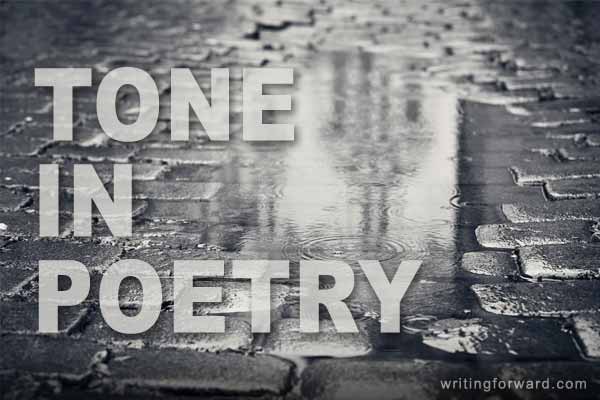In literature, tone is the mood, attitude, or emotional sensibility of a written work. In poetry, tone expresses the narrator’s disposition toward the poem’s subject, the reader, or the narrative itself.
We might describe a poem’s tone as irreverent, relaxed, sarcastic, solemn, jubilant, or desperate. Tone can be any emotion or state of mind, and a single poem can include a combination of tones.
When we’re speaking, our tone is expressed through inflection. We use pitch and stress to communicate the attitude behind the words we’re saying. If I say, “Get out of here!” the tone of my voice will let you know whether I’m literally telling you to leave the room or whether I’m figuratively saying, “You’ve got to be kidding.”
In writing, we must approach tone with care, because it is often and easily misinterpreted. For example, sarcasm is commonly misread in text messaging and on social media. Someone types a sarcastic statement in jest, but the recipient takes it literally and may get offended or confused. Some people mark sarcastic remarks with <sarcasm> to ensure clarity for this reason.
If communicating tone is so difficult, how can we interpret and communicate it effectively in poetry?
Tone in Poetry
Tone is conveyed through every aspect of a poem: imagery, connotation, even rhythm.
Consider two poems about death. One poem might use an image of a sunset while another uses dried flowers. The image of a sunset is warm, restful, even relaxing. But the dried flowers are brittle and lifeless. The image that the poet chooses will determine whether the poem’s tone is comforting or despairing.
Connotation is similarly crucial in poetry. Think about the difference between the word bum and the word pauper. Although these two words might be used to describe the same person or situation, they have strikingly different connotations. In a poem about poverty, the word choice will tint the meaning and reveal the poem’s attitude toward someone who’s destitute.
A poem’s rhythm can also contribute to its tone. As mentioned, when we speak, our inflections help listeners determine the attitude behind the words we’re saying. Rhythm is used similarly in poetry to affect tone. Short, snappy lines could make a poem feel frantic or excited. Lengthy lines with a lot of long vowels can give a poem a relaxed or haughty tone.
These are just a few examples of elements that convey tone in poetry. Can you identify any other literary devices that are common in poetry and explain how they might be used to convey tone?
Studying Tone in Poetry
Consider the confident, sassy attitude of Maya Angelou’s “Phenomenal Woman” contrasted with the sorrowful yet playful tone of “anyone lived in a pretty how town” by E.E. Cummings, or contrast the tone of Robert Frost’s “The Road Not Taken” with the tone of Emily Dickinson’s “Because I Could Not Stop for Death.” How do these poems differ in tone? How did the poets convey tone? And how does the tone of each poem affect the reader?
Select two poems from the literary canon and for each one, choose one to three words that describe its tone. Then look for the elements within each poem that convey its tone (metaphor, imagery, etc.) and note those as well, pulling lines, phrases, and words from the poem to support your interpretation. Finally, write a short essay of about one page comparing and contrasting the tones of the two poems and explaining how each poem communicates its tone.
How Do You Tone?
When you review your work, do you check for tone? Have you ever made revisions because the language in a poem wasn’t conveying the right tone? Share your thoughts on tone in poetry by leaving a comment, and keep writing poems!





That’s a wonderful post. You explained the difference very well esp examples.
Thanks, Shayra.
It still feels confusing at times, distinguishing between tone and mood in poetry. It seems like there is an overlap of descriptive words that can be used for either. What do you think of this way of figuring out the difference: “tone is what the dog hears” and mood is “how the dog reacts to what she hears”?
Hi Judith. If you read the post, you’ll see that it says “tone is the mood, attitude, or emotional sensibility of a written work.” In this case, we’re not distinguishing between tone and mood. I would also use atmosphere to describe this concept.
Thank you for this great overview of how to manage tones in letters and poems. Best wishes, Michael
You’re welcome!